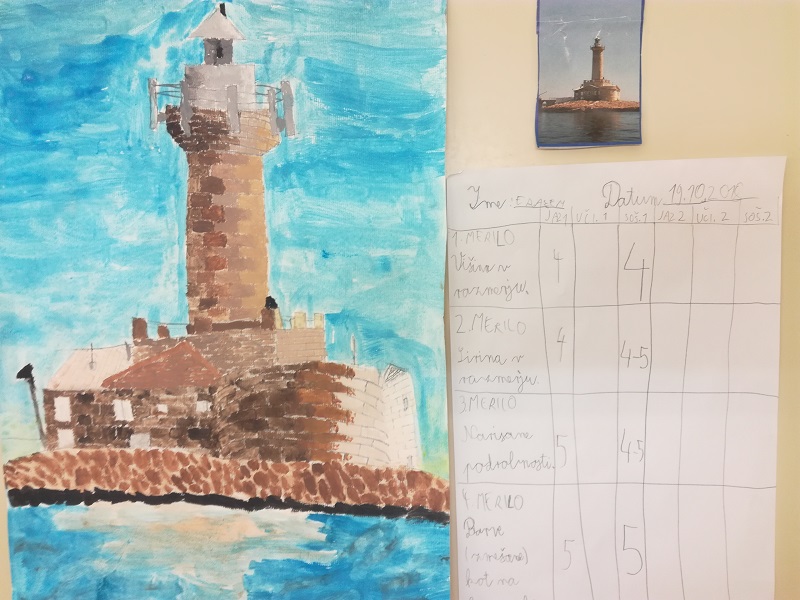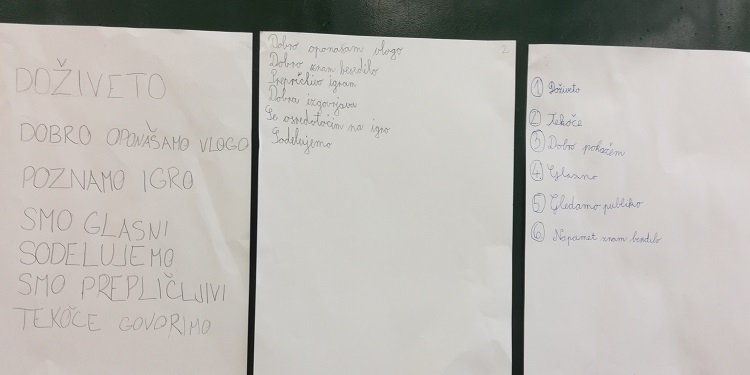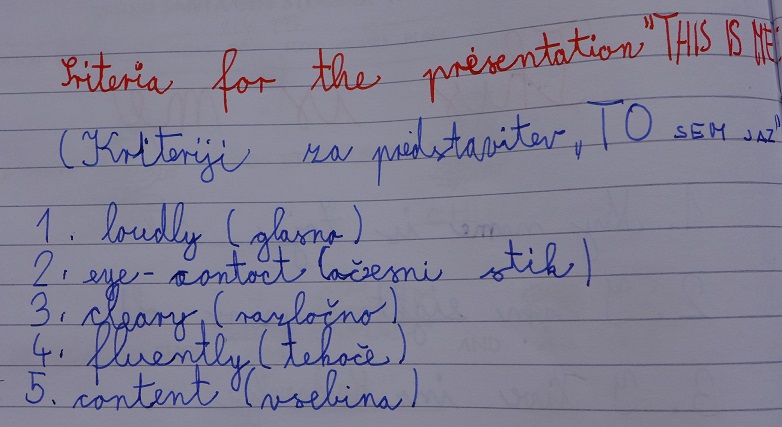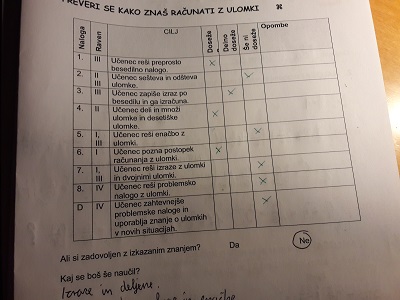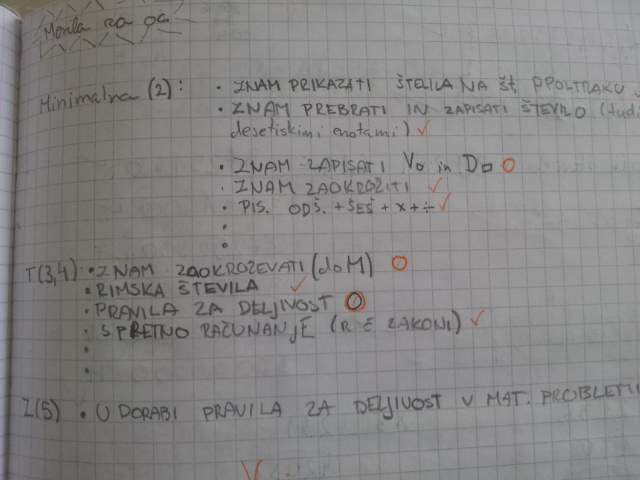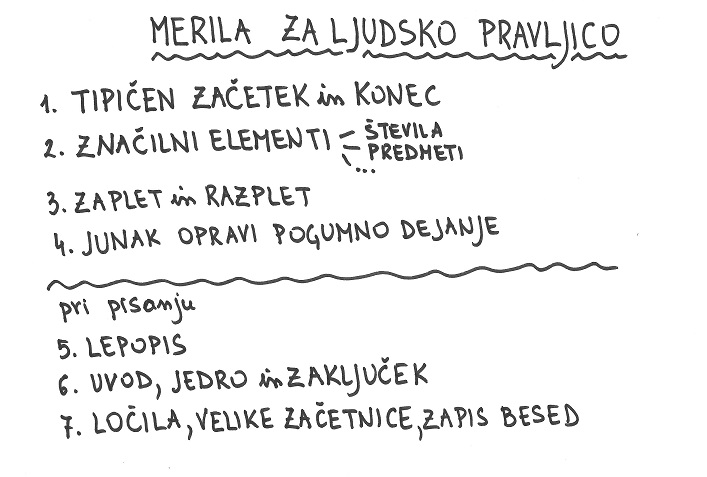THE ASSESSMENT OF THE QUALITY OF THE LEARNING PROCESSCriteria
The criteria are divided into three categories:
- Criteria for open learning intentions (Shirley Clarke)
- Criteria for closed learning intentions (Shirley Clarke)
- Criteria for final evaluation, also known as criteria for summative evaluation
On the right: The criteria at the end of the chapter written down in pupils’ notebooks so that the pupils can use them while studying or self-assessing.

FORMING AND SETTING CRITERIA IN THE CLASSROOMExample
Kristina Ferel
STEP 1: Collect examples of work (presentations, writings)
We choose a few examples of previous assignments from the pupil’s notebooks.
For oral presentations the pupils prepare their presentation with the help and guidance of the teacher. They first present their topic to their best friend (then to a group of classmates, finally those who feel comfortable enough can present in front of the entire class).
For show and tell as well as physics, biology, chemistry, and geography reports the pupils can use examples of reports from previous years. (The pupils first present their work to the teacher, their best friend, and a group of classmates. Then only those pupils who feel comfortable enough present in front of the whole class.)
STEP 2: Analysing the work by pointing out its strengths or what we can learn from it.
We analyse the assignments by using an OHP or an electronic whiteboard to project scans of the assignments for the entire class to see. The pupils voice their opinions on each of the assignments. They name the strengths and weaknesses of each work, list what they think is the most important part of the assignment, point out if anything is missing, or suggest what could be improved upon. We focus on the positive aspects of each example and not on the negatives.
The same principle applies to oral presentations as well. We look at each of the presentations and try to find what we like about them. We also define what criteria will be used to determine the best oral presentations in the future.
STEP 3: Writing the criteria with the pupils (using their own words).
During the analysis, we write down the criteria onto a poster or piece of paper. We write down the criteria using the pupils’ own words and expressions. All the pupils need to understand the criteria and have to agree with them. That’s how we ensure that the pupils will use the criteria when preparing their assignments and will be able to self-assess in a more accurate manner. Always leave enough space on the poster so that more criteria can be added later on. The same poster can be used as the pupils move on to the next grade if we adapt it to suit their progress.
STEP 4: Writing self-reflections or self-evaluations.
Writing down the evaluation of a chosen assignment. We choose the best assignment out of all of the submissions and either write an evaluation of the assignments based on the criteria we set beforehand or start planning the next assignment. When the pupils are writing their self-evaluation, we help them form coherent sentences or assist them in writing check-lists outlining different criteria. We can use colours, emojis, and other distinct ways of marking different goals. Once the pupils learn how to write successful and accurate self-evaluations, it’s good to teach them how to express their opinions on their own assignments (or the work of their classmates) orally as well. This helps pupils become more self-assured when describing and defending their qualities which helps them build confidence. While the pupils are listening to their peers’ evaluation of their work, we teach them that they can either accept their classmates’ opinions or not. This helps the pupils learn that there is nothing wrong with having different opinions.
STEP 5: Choosing an assignment for self-evaluation. The pupils had to choose between two assignments and select the better one based on the criteria we set beforehand. They also had to submit the arguments backing their choice in written form.
We can use the same or similar methods and approaches for several different skill levels, grades, and age groups. You can find an example of a similar case of evaluating project work in the video here.

EXAMPLES FROM THE CLASSROOM Criteria for closed learning intentions
You can find the instructions on how to create the processing criteria necessary to complete a particular task on page 51 of the handbook Formative Assessment in Practice (Mateja Peršolja). Here is an example of one of the lessons on the subject of Algebraic Expressions from the 8th grade of primary school.
The pupils used books and various other sources (images, explanations, and examples of already solved mathematical problems) to try and figure out how to multiply two polynomials. They had to use the examples given to solve the expression (x + 2)(x + 5) by themselves. Once the pupils completed the task they worked in groups to write down their processing criteria, meaning the steps needed to simplify the given expression. The photo on the right shows the examples produced by the pupils.
Those pupils for whom Maths isn’t a strong suit couldn’t form these criteria on their own, while the most successful pupils wrote down only one step for solving the expression. That step being: multiply each term in one polynomial by each term in the other polynomial. Other groups wrote down two, three or four steps, as can be seen in the photograph.
SUMMARY: At the end of this lesson the pupils understood the process of multiplying polynomials better than if I had explained it in front of the class, because all of them solved the problems they chose correctly. I spent more of my time helping less academically gifted pupils by guiding them through solving one or two examples, then allowing them to continue solving the remaining mathematical expressions on their own. My pupils finished the tasks at a pace that best suited them – some solved ten problems, while others only solved two in the same period of time.
What does this tell the teacher? When you see how your pupils think and how they approach a particular task based on their prior knowledge, when you enable visible learning and allow the pupils to give you feedback, you realise that it is impossible to explain a particular topic or rule using only one approach and expect all pupils to understand it. As a teacher, I would most likely write down the same explanation as the most talented pupils in the class. But as you can see, the pupils used different ways of achieving the same goal, and most of them probably wouldn’t have understood my explanation or would have found it lacking.


EXAMPLES FROM THE CLASSROOM The criteria for closed learning intentions when teaching literacy
On page 51 of the handbook Formative Assessment in Practice (Mateja Peršolja) you can find the instructions on how to create the processing criteria necessary to complete a particular task.
Here is an example of criteria using pictograms: Skip empty rows.
It was made by Kristina Ferel and her pupils who weren’t literate yet.



